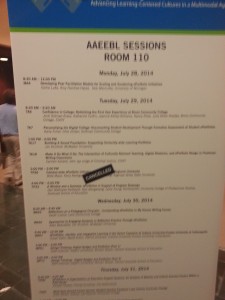Digital Marginalia is an infrequent blog post series that captures some links I’ve retweeted or looked at, grouped into a theme, and commented on.
Disrupting Education/Learning – Whatever that Means
There’s two related bunch of links that are tied here; the first being the onslaught of Richard Branson, Disrupting Education:
http://www.virgin.com/richard-branson/disrupting-old-education-models
http://www.virgin.com/richard-branson/education-outside-the-classroom
And the response:
http://cogdogblog.com/2015/10/05/richard-branson/
It’s strange because I understand what Branson’s saying, and yes, education needs more flexible education. But to criticize something he doesn’t really know, because he didn’t go into it forty years ago, and isn’t part of it now, and clearly doesn’t get that in fact, higher education does do a lot of the things he says it doesn’t. Business schools basically train their graduates to be startups. Many, many MBA programs have that as their overarching theme. Our Master’s level Engineering program is based on a business project model with real clients. We aren’t unique in this. Our Geography department have several trips to real world places to do the work that they will do post-graduation. When I went to community college a decade ago, we took several entrepreneurship classes, because they knew that software designers would likely be their own bosses. Should things be more flexible? Yes. Often the reason things aren’t flexible is because someone, somewhere along the line bought a student information system that can’t schedule things in less than three hour blocks, or doesn’t understand that a course isn’t 14 weeks. That’s the sort of flexibility that the private sector brings you. Get real, Branson. Martin Weller said it better (first link under responses) so go read his post and give it some love because it’s so terribly spot on.
https://www.lrng.org/
“LRNG redesigns learning for the 21st century so that all youth have an opportunity to succeed.”
Really, I don’t have any non-vulgar words… OK here’s a fact you may want to consider, YOU CANNOT REDESIGN HOW I LEARN. I control how I learn. YOU control how you communicate information to me; I control how I receive that information. If you do not agree, then you are working on a paradigm that reinforces that students are empty vessels that need to be filled with knowledge. Again, I agree with connecting someone’s passion with learning, doing it through an online medium, sure that’s awesome. I love the Cities of Learning program, I really do. Just “redesigning learning” is like saying you’re “redesigning eating”.
Closing of the Open Web
http://www.theguardian.com/technology/2015/oct/06/reddit-upvoted-launches-aggregated-news-site–with-no-comments-allowed
http://motherboard.vice.com/read/im-on-twitter-too
Commenting, whether you think it valuable or not, is one of the best features of the world wide web. The amount of time I’ve found something in the comments of an article that links to another great thing is staggering to think about. The Vice thing is kind of delicious, in that after years of cultivating this vacuous audience (looks directly at Dos & Don’ts) they now want a civilized discussion. I guess people can grow up, but instead of turning off comments, why don’t you do like many other places and cultivate the commentary by moderating it. That way, you approve the good stuff and your audience doesn’t have to change the way they interact with the site.
Privacy
http://campustechnology.com/articles/2015/09/28/deep-learning-privacy-research-gets-google-go-ahead.aspx
Google and privacy? Uhhh, the jokes write themselves.
http://motherboard.vice.com/read/how-to-see-what-facebook-tells-advertisers-about-you
Undoubtedly, not all of what Facebook tells itself about you.
Manditory watching. Glenn Greenwald is one of the most important journalists of our time. Seriously undervalued/rated.
